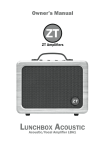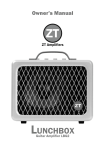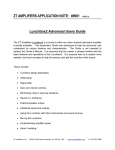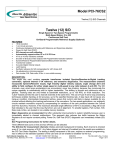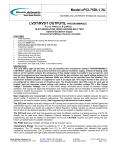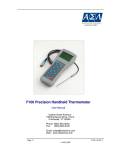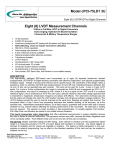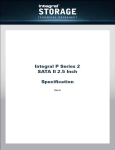Download ZT LBA1 Owner`s manual
Transcript
Owner’s Manual ZT Amplifiers LBA1 IMPORTANT SAFETY INSTRUCTIONS CAUTION RISK OF ELECTRIC SHOCK DO NOT OPEN CAUTION: TO REDUCE RISK OF ELECTRICAL SHOCK, DO NOT REMOVE COVER (OR BACK). NO USER SERVICEABLE PARTS INSIDE. REFER TO QUALIFIED SERVICE PERSONNEL. The lightning flash with the arrowhead symbol, within an equilateral triangle, is intended to alert the user to the presence of uninsulated “dangerous voltage” within the product’s enclosure that may be of sufficient magnitude to constitute a risk of electric shock to persons. The exclamation point within an equilateral triangle is intended to alert the user to the presence of important operating and maintenance (servicing) instructions in the literature accompanying the appliance. WARNING: TO REDUCE THE RISK OF FIRE OR ELECTRIC SHOCK, DO NOT EXPOSE THIS APPLIANCE TO RAIN OR MOISTURE. THE APPARATUS SHALL NOT BE EXPOSED TO DRIPPING OR SPLASHING AND THAT NO OBJECTS FILLED WITH LIQUIDS, SUCH AS VASES, SHALL BE PLACED ON THE APPARATUS. 1. READ INSTRUCTIONS - All safety and operating instructions should be read before the appliance is operated. 2. RETAIN INSTRUCTIONS - Safety and operating instructions should be retained for future reference. 3. HEED WARNINGS - All warnings on the appliance and in operating instructions should be adhered to. 4. FOLLOW INSTRUCTIONS - All operating and use instructions should be followed. 5. WATER AND MOISTURE- The appliance should not be used near water - near bathtub, washbowl, kitchen sink, laundry tub; in a wet basement near a swimming pool, etc. 6. CARTS AND STANDS - Do not place this product on an unstable cart, stand, tripod, bracket, or table. The appliance should be used only with a cart or stand that is recommended by the manufacturer. 7. VENTILATION - The appliance should be situated so that its location and position do not interfere with proper ventilation. The appliance should not be situated on a bed, sofa, rug, or any surface that may obstruct cabinet openings. 8. HEAT - The appliance should be situated away from heat sources such as radiators, heat registers, stoves, or other devices (including amplifiers) that produce heat. 9. POWER SOURCES - This product should be operated only from the type of power source indicated on the marking label. If you are not sure of the type power supply in your home, consult your product dealer or local power company. For products intended to operate from battery power or other sources, refer to the operating instructions. 10. POWER CORD PROTECTION - Power supply cords should be routed so that they are not likely to be walked upon or pinched by items placed upon or against them, paying attention to cords and plugs, convenience receptacles, and the point where they exit from the appliance. 11. POLARIZED PLUG - This appliance is equipped with a polarized line plug (a plug having one blade wider than the other). This plug will fit into the power outlet only one way. This is a safety feature. If you are unable to insert the plug fully into the outlet, try reversing the plug. If the plug still fails to fit, contact your electrician to replace your obsolete outlet. Do not attempt to defeat this safety feature. 12. LIGHTNING - For added protection for this product during a lightning storm, or when it is left unattended and unused for long periods of time, unplug it from the wall outlet and disconnect the antenna or cable system. This will prevent damage to the product due to lightning and power line surges. 13. OVERLOADING - Do not overload wall outlets, extension cords, or integral convenience receptacles, as this can result in a risk of fire or electric shock. 14. CLEANING - Unplug this product from the wall outlet before cleaning. Do not use liquid cleaners or aerosol cleaners. Use a damp cloth for cleaning. 15. NON-USE PERIODS - This amplifier should be unplugged from the outlet when the appliance is left unused for a long period of time. 16. OBJECT AND LIQUID ENTRY - Never push objects of any kind into this product through openings, as they may touch dangerous voltage points or short-out parts that could result in a fire or electric shock. Never spill liquid of any kind on this product. 17. DAMAGE REQUIRING SERVICE - The appliance should be serviced by qualified personnel when: a. The power supply cord or plug has been damaged; or b. Objects have fallen on or liquid has been spilled into the appliance; or c. The appliance has been exposed to rain; or d. The appliance does not appear to operate normally or exhibits a marked change in performance; or e. The appliance has been dropped or the enclosure is damaged. 18. SERVICING - Do not attempt to service this product yourself, as opening or removing covers may expose you to dangerous voltage or other hazards. Refer all servicing to qualified service personnel. For service warranty information call the ZT Amplifiers service number: 1-510-704-1868. 19. REPLACEMENT PARTS - When replacement parts are required, be sure the service technician has used replacement parts specified by the manufacturer or that have the same characteristics as the original part. Unauthorized substitution may result in fire, electric shock, or other hazards. 20. SAFETY CHECK - Upon completion of any service or repairs to this product, ask the service technician to perform safety checks to determine that the product is in proper operating condition. CAUTION TO PREVENT ELECTRICAL SHOCK, DO NOT USE THIS (POLARIZED) PLUG WITH AN EXTENSION CORD, RECEPTICLE OR OTHER OUTLET UNLESS THE BLADES CAN BE FULLY INSERTED TO PREVENT BLADE EXPOSURE Turn clockwise to increase the Bass Adjusts the Channel level 1/4" plug in connection for Instrument LED - Lit when Amplifier is on I N S T R U M E N T INPUT VOLUME GAIN Adjusts level of the Amplifier 2 Turn clockwise to increase the Treble BASS TREBLE REVERB Adjusts the Reverb level 3 1 OFF FEEDBACK CUT M I C R O P H O N E Adjusts the Feedback Cut Microphone 1/4" plug input 1/8" plug in connection for Mp3 Player 1/4" plug connections for the external effects loop / Line Volume MIC IN Microphone XLR input Adjusts the loudness of the headphone/ line out Phantom Power ON EFX Selects amplifier operating voltage 115V or 230V Send / DI Return / Line Out Acoustic / Vocal Amplifier LBA1 Voltage ZT Amplifiers, Inc. Berkeley, CA 94710 USA 115 Mic channel phantom power on and off Aux Input This device complies with Part 15 of the FCC Rules. Operation is subject to the following two conditions: (1) this device may not cause harmful interference, and (2) this device must accept any interference received, including interference that may cause undesired operation. Power RISK OF ELECTRIC SHOCK DO NOT OPEN Off WARNING: SHOCK HAZARD - DO NOT OPEN AVIS: RISQUE DE CHOC ELECTRIQUE - NE PAS OUVRIR ~115V/230V 60HZ/50HZ 200W Plug in power cord connection Turns power on and off External On CAUTION CAUTION: FOR CONTINUED PROTECTION AGAINST FIRE, REPLACE ONLY WITH SAME TYPE 250V FUSE Speaker Internal WARNING: TO REDUCE THE RISK OF FIRE OR ELECTRIC SHOCK, DO NOT EXPOSE THIS APPLIANCE TO RAIN OR MOISTURE 1/4" plug in connection for headphone/ line out External Speaker Out 8Ω Minimum Switches between internal and external speaker FUSE T2AL 250V Fuse - Protects the amplifier from electrical faults. Replace only with the same type and rating as listed on the fuse 1/4" plug in connection for external speaker The LUNCHBOX Acoustic is ZT’s first two-channel amp, with perfect features and tone for the acoustic musician and vocalist. Featuring specially voiced, independent Instrument and Microphone channels, flexible signal I/O, and high-output capability, the easily portable LUNCHBOX Acoustic is truly a performer’s best friend. Like all ZT products, The LUNCHBOX Acoustic is simple and intuitive enough to allow anyone to plug and play without much effort. However, reading this document can help you get the most from your amp, and deliver the best to your audience. Design Philosophy: The LUNCHBOX Acoustic is built on the platform of ZT’s original LUNCHBOX amp. By utilizing proprietary technology and taking a fresh approach to design, ZT has created another powerful tool for the performing musician, this time with sound and features specifically suited for acoustic instrument players and vocalists. ZT products are the result of many years of study into the sound, feel and science of the world’s best musical instrument amplifiers. Our goal was not to clone or “model” any particular product. Rather, we have tried to understand, in a methodical way, what technical factors give an amp great tone, flexibility and playability. As a group of experienced audio scientists and passionate musicians, we set out to learn what makes a classic amp survive for generations, giving artists of many styles and genres a consistently great playing experience over the years. ZT’s research investigation was “clean slate.” We didn’t assume we knew any secret, magic formula; we set our own techno-biases aside. Likewise, we did not assume that conventional wisdom is always all that wise. What we found is that guitar amps are fantastically complex systems. Many aspects of the overall product design interact with one another under real-world playing conditions. Sections of the electrical circuit influence each other, the electrical system interacts with the acoustical system, etc. Some of these interactions are well known to amp aficionados and designers. Others have been underrated, or overlooked entirely. Thus, we soon came to realize that guitar amps have plenty of mysteries to reveal, and plenty of room for improvement in areas that musicians would appreciate. Eventually, ZT started collecting real, practical insight into what makes great amps tick. In our view, optimization between electrical, acoustical and mechanical subsystems is the key to bringing more tone, power, smaller size, and lower costs into the picture. By applying sophisticated technical understanding to overcome limitations that have previously been considered facts of life, ZT is able to re-write some of the rules while working in complete harmony with more traditional approaches. We believe it is time to re-think the fundamental design of the guitar amp, bringing in advanced audio technology without losing the wonderful benefits of proven classics. The Signal Path: The LUNCHBOX Acoustic has two main channels, one for your acoustic INSTRUMENT and one for your favorite MICROPHONE. The Instrument channel has a standard ¼” jack on the top panel feeding a Hi-Z preamp for tonal compatibility with most acoustic-electric pickups. The Microphone input has two jacks on the rear panel, a standard ¼” and an XLR with switchable 12-volt Phantom Power. These feed a Lo-Z preamp to capture the full dynamics of your microphone. All the main inputs are protected against RF interference and ground-error overloads. The Instrument and Microphone preamps feature separate analog GAIN controls on the top panel for easy adjustment of each channel’s input sensitivity. Following the analog input preamps, the signals are converted to 24-bit PCM digital at a 44.1 KHz sampling rate. In the digital domain, ZT’s proprietary dynamics and EQ signal processing are implemented. Also, channel-specific TREBLE and BASS tone controls with characteristics closely following a vintage stack are applied. Additionally, the LUNCHBOX Acoustic has individual REVERB controls, offering the option of different signal echo & decay for Instrument and Microphone channels. At this point, the signals are converted back to analog and routed to the selectable FEEDBACK CUT circuit. The final preamp stage mixes the Instrument and Microphone channels with the stereo AUX INPUT ( 1/ 8” jack on rear panel) and routes them to the buffered EFX loop. The EFX SEND can be used as a DI or Line output without interrupting the LUNCHBOX Acoustic’s internal signal path. However, plugging into the EFX RETURN will disconnect the internal signal path, replacing it with the output from your effects. Finally, an analog master VOLUME is applied to the mix just before sending it to the power amplifier. The output amp section is carefully designed to constantly adapt to the signal characteristics and the instantaneous power supply behavior. The amp itself is a pair of Class A/B output stages, running fully bridged across the speaker load. The result is very high RMS power, with extraordinary additional peak power on top of that. We feel this is the only way to deliver the demanding dynamics of acoustic instruments to your audience. The LUNCHBOX Acoustic includes an adjustable HEADPHONE output and a switchable EXTERNAL SPEAKER jack on the rear panel (8 Ω minimum). Main Inputs: The ¼” INSTRUMENT channel input is located on the top panel of the LUNCHBOX Acoustic. This input is shorted when not in use to reduce noise. The MICROPHONE channel inputs are located on the rear panel of the LUNCHBOX Acoustic . Both ¼” and XLR Microphone inputs are provided, with switchable Phantom Power on the XLR input. Phantom Power: The LUNCHBOX Acoustic Microphone channel offers a 12v Phantom Power feature. If you are using a condenser microphone, set the Phantom Power switch to On and connect it using a standard XLR microphone cable. Initial Setup: When first connecting your LUNCHBOX Acoustic, before power is applied, please be sure to set the controls as follows: • REVERB set to off. (Fully counter-clockwise.) • BASS set to mid-point. (12 o’clock position.) • TREBLE set to mid-point. (12 o’clock position.) • VOLUME set to off. (Fully counter-clockwise.) • GAIN set to mid-point. (12 o’clock position.) • FEEDBACK CUT set to off. (Fully counter-clockwise.) • SPEAKER switch on rear panel set to “Internal” position. (Towards left side.) • Now you can apply power, and turn up your instrument and/or microphone to the desired level using the VOLUME knob. Gain and Volume: Normal adjustments to the sound level should be made using the master VOLUME control only. This knob affects the signal levels going into the LUNCHBOX Acoustic’s high-power amplifier. It does not affect the electrical level at the EFX SEND jack, but will affect the sound level of all other outputs (Internal or External Speaker, and Headphones). The GAIN controls are used to set the input sensitivity of each channel. In most cases, these controls should be set high up, generally above the 50% point of their ranges. This will assure a good tone, and low operating noise. Of course, you might have to adjust the GAIN controls to feed your favorite effects properly. The key to low noise is to keep the GAIN knob high, and use the VOLUME knob to adjust your sound level. Bass and Treble: The LUNCHBOX Acoustic features separate BASS and TREBLE controls for Instrument and Microphone channels. At ZT, we don’t take these features lightly. We studied classic and modern tone controls, noting each one’s strengths and weaknesses. In the spirit of the original LUNCHBOX amp, the LUNCHBOX Acoustic provides an extraordinarily wide palette of tones using simple controls, giving you quick access to just the sound you seek. Reverb: The LUNCHBOX Acoustic’s REVERB effect is a traditional plate style reverb that simulates the echo and decay of sound reflections in a room or hall. You can adjust the amount of REVERB on both the Instrument and Microphone channels from the top panel. ZT’s proprietary dynamic processing handles other sonic features as you play, but we give you the flexibility to separately control this primary sonic flavor. Feedback Cut: The LUNCHBOX Acoustic’s FEEDBACK CUT feature is designed for a quick, simple elimination of feedback. The FEEDBACK CUT is a master control that affects both Microphone and Instrument channels. When FEEDBACK CUT is set to Off, the LUNCHBOX Acoustic delivers it’s normal EQ curves. Positions 1, 2, and 3 target specific frequencies that are common feedback offenders. Each different knob position carves a notch in a different frequency. This feature is not guaranteed to solve every feedback problem in every environment, but we have found it to be very effective in most situations. (Hint: If you are playing your acoustic guitar close to and facing the amplifier at a high volume, you will experience feedback. Move away from, or turn the instrument away from the amp.) AUX Input: The LUNCHBOX Acoustic can accept a stereo line input from an audio source such as a PC, CD, or MP3 player via a standard 1/ 8” Stereo jack on the rear panel, labeled AUX INPUT. This input is only affected by the master VOLUME control; no other signal processing is applied (unless you’re going thru the EFX loop). To adjust the relative balance between your guitar or microphone and your MP3 player, you can use the GAIN controls and the output volume on your player. We recommend that you disconnect any cables from the AUX INPUT when it is not in use. EFX Loop: Allows effects to be inserted after the input stage, resulting in a cleaner, more defined output signal under many conditions. The Send/DI output can also be used as a direct output to a powered system such as another amplifier or a P.A. However, plugging into the EFX Return will interrupt the LUNCHBOX Acoustic’s internal signal path (except for the master VOLUME), so that the sound can be sent to, and received from, your effects rig. Be aware that any effect connected via the EFX Loop will be applied to both Microphone and Instrument channels on the LUNCHBOX Acoustic. Headphone/Line Level Output: This ¼” Stereo connector can be used to run most stereo headphones. (However, the signal itself is always mono.) The line output is also useful for running into house sound, or a recording rig. It has its own level adjustment, so that you can adjust the level of your phones once the LUNCHBOX Acoustic controls are set where you want them. Unlike most headphone outputs, this one doesn’t mute the internal speaker. If you want to do that, just set the SPEAKER switch to External. This approach gives you total control of what is on or off at any given time. For example, you can use the LUNCHBOX Acoustic to monitor the sound on stage, even when routing into the board via the line out. The External Speaker Output: There is a ¼” external speaker output connector on the rear of the LUNCHBOX Acoustic, which can be used to power an external cabinet. Please note the following IMPORTANT rules: • The LUNCHBOX Acoustic is not designed to power both internal and external speakers simultaneously. The external speaker output will not operate unless SPEAKER switch is set to External. • This output is fully balanced and high power. Connect it only to a passive speaker cabinet. • Do not use this output for recording or connect it to other amps. • Use a speaker cabinet rated at 8 Ω, or higher. • Be sure your external cabinet can handle at least 100W. Using The LUNCHBOX Acoustic With Other Instruments: The LUNCHBOX Acoustic Instrument channel is not just for acoustic guitars. In fact, the LUNCHBOX Acoustic loves a very wide variety of instruments and sound sources. Excellent results have been achieved with electric guitars (especially with jazz tones!), slide guitar, harmonica, electric piano, sax, accordion, electronic organ, traditional string instruments, and synths. Start with the GAIN, BASS, TREBLE, and REVERB controls all set at midpoint, and the VOLUME all the way down. Then inch up the VOLUME, step by step. Season to taste. Because of the high available gain, some acoustic instruments may tend to feedback if the GAIN control is accidentally set too far up. Mic’ing The LUNCHBOX Acoustic: When making a recording, or running through a house PA, a great sounding amp really deserves to be mic’d. Direct feeds are convenient, sometimes necessary, but they rarely capture the full tone the player is hearing. Like all ZT products, the LUNCHBOX Acoustic’s sound is a result of a synergistic system, and the internal speaker is an important part of that system. Getting really good recordings always involves experimentation, but here are some general tips: • Start with the microphone directly in front of the driver’s dustcap, about 6” back from the grille. • Cardioid LD condensers are the first choice, if available. • Cardioid SD’s are good, too. • An Omni SD can capture a very accurate sound, but you might have move it in closer to the grille, and play with side-to-side positioning. A spot about halfway between the center (“dustcap”) and the outer edge (“surround”) of the speaker will often work well. • The classic dynamic guitar amp mics can work, of course, but be prepared to try a variety of setup positions to get the tonal balance you want. • Remember, the LUNCHBOX Acoustic can be loud, and it concentrates a great deal of sound energy into a small area. Unless you are an unusually soft player, you will probably have to engage the pad on your mic. • Using a foam windscreen is also a good idea, since the driver can create bursts of air when driven very hard. Understanding Amplifier Power: Nobody has come up with one number that can fully represent the power capability of a guitar amp. RMS is a very conservative approach, but it misses the issue of dynamic power and real world musical signals. At the other extreme, Peak Power can readily be inflated to the point where it is not a reliable indicator of anything. In fact, the actual power of any given amplifier varies widely at different frequencies. Every amplifier company has their own procedure for stating the power capability of their products, which ideally should be done within the boundaries of accepted technical standards and legal requirements. Here is our thinking on the matter, which we believe results in specifications that are both conservative and useful. The internal speaker of the LUNCHBOX Acoustic is nominally 8 Ω, with a DC resistance of 5.3 Ω. Electrically, the amplifier output stage runs differentially, using a 48V rail. The output stage can source in excess of 41Vp or 28Vrms into the speaker load. This yields the following typical specs: Maximum Instantaneous Peak Power: 280W. Musical Peak Power: 236W. RMS Power: 130W. Sustained Average Music Power: 200W. Finally, Two Words About Modding: Please Don’t. Sooner or later, most of us get the urge to modify or improve our amps by replacing various parts. But, remember, the LUNCHBOX Acoustic is not like other guitar amps. It is a highly integrated and optimized system, combining electrical, acoustical and mechanical subsystems. Replacing any element of this combination is sure to upset the balance and operation of the whole. For example, our speaker driver is fully custom, and built using special high-power components. You won’t find anything else quite like it. So enjoy your LUNCHBOX Acoustic, and please do send us any and all suggestions you have. We take our customers’ input very seriously. (Oh, and we like compliments, too!) Thanks! *** Specifications Dimensions: (h) 192mm / 7.5” (w) 250mm / 9.8” (d) 196mm / 7.7” Weight: 5.4kg / 12lbs. Output: 200 watts, greater than 130dB @ 1 meter / 3.3’ Voltage: Switchable - 115V / 230V Controls: Top Panel: Dual Channel Volume, Gain, Bass, Treble, Reverb Master Volume , Feedback Cut Rear Panel: Line Out/Headphone Level, Speaker Switch Speaker: 165mm / 6.5” Cabinet: MDF (High Density Fiber Board) High Gloss Finish Technical Support Technical questions: Email: [email protected] Telephone: 1-510-356-4077 To obtain service for your ZT product: Your dealer should be your first contact if you experience technical problems with your ZT product. Contact your dealer with a specific description of the problem, and have your purchase receipt available for purchase date proof (this will determine if your product is within ZT’s warranty coverage period). Your dealer will contact ZT and make arrangements for repair or replacement of your product. If your product is not within warranty period, you will be advised of repair charges. Limited Warranty ZT Amplifiers, Inc., warrants that the ZT product you have purchased shall be free of defects in parts and workmanship if used under normal operating conditions for a period of one (1) year from the date of purchase. This limited warranty shall run to the original purchaser when purchased from an Authorized ZT Dealer and any transferee of a retail purchaser. This limited warranty covers normal use of the ZT product only, and does not cover damages caused by misuse, abuse, accidents, or unauthorized service or parts. IMPORTANT: PLEASE RETAIN YOUR SALES RECEIPT, AS IT IS YOUR PROOF OF PURCHASE COVERING YOUR LIMITED WARRANTY. TO TRANSFER THE WARRANTY TO A SUBSEQUENT PURCHASER, YOU MUST ENDORSE THE SALE OF THE PRODUCT TO THE SUBSEQUENT PURCHASER ON THE FRONT OF THE SALES RECEIPT. THIS LIMITED WARRANTY IS VOID WITHOUT SUCH ENDORSED SALES RECEIPT. Defective products that qualify for coverage under this limited warranty will be repaired or replaced, at ZT’s discretion, with a like or comparable product, without charge. The ZT Amplifiers Dealer from whom you purchased your product may be authorized for warranty service, and should be your first point of contact when service is required. To receive warranty service from ZT Amplifiers, you must contact ZT Amplifiers by email during the warranty period at [email protected] to explain the defect and to obtain an RMA number (return materials authorization number), then return the complete product (in original packaging, if available) to an Authorized ZT Amplifiers Service Center, with proof of purchase, during the applicable warranty period. You are responsible for shipping the defective product to the Service Center. Return shipment will be provided at no cost to you; provided, however, that if you are located in a country other than the United States of America, then you will be responsible for all customs duties, VAT and other associated taxes and charges applicable to the shipment of the product. Any repair or service performed by any person or entity other than an Authorized ZT Amplifiers Service Center is not covered by this limited warranty. This limited warranty becomes void if the serial number on any product is defaced or removed, or the product has been damaged by alteration, misuse, accident, or neglect; or the product has been repaired or serviced by persons not authorized by ZT Amplifiers. THE FOREGOING CONSTITUTES THE ONLY WARRANTY MADE BY ZT AMPLIFIERS WITH RESPECT TO THE PRODUCTS AND IS MADE EXPRESSLY IN LIEU OF ALL OTHER WARRANTIES EXPRESS OR IMPLIED. Any implied warranties, including, without limitation, any implied warranties of merchantability or fitness for any particular purpose, imposed under the law of any applicable jurisdiction are limited to the duration of this limited warranty. ZT AMPLIFIERS ASSUMES NO LIABILITY FOR PROPERTY DAMAGE RESULTING FROM ANY DEFECT OF THIS PRODUCT NOR ANY LOSS OF BUSINESS, INCOME, PROFIT, SATISFACTION, OR DAMAGES ARISING FROM THE LOSS OF USE OF SAME DUE TO DEFECTS OR AVAILABILITY OF SAME DURING SERVICE. NOTWITHSTANDING ANY DAMAGES YOU MIGHT INCUR FOR ANY REASON WHATSOEVER, THE ENTIRE LIABILITY OF ZT AMPLIFIERS SHALL BE LIMITED TO THE AMOUNT ACTUALLY PAID BY YOU FOR THE DEFECTIVE PRODUCT. Some jurisdictions do not allow the exclusion or limitation of damages or limitations on how long an implied warranty lasts, so the above limitations may not be applicable to you. EFFECTIVE DATE: December 1, 2008 ZT AMPLIFIERS, INC. 2329 FOURTH STREET BERKELEY, CALIFORNIA 94710 USA











